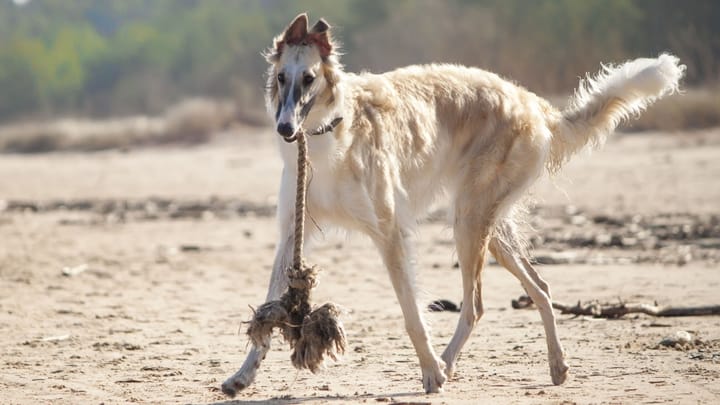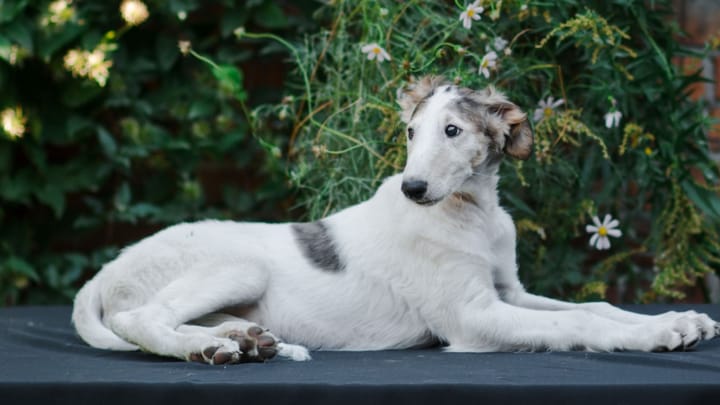Borzoï
Other names : Barzoï, Russian wolfhound, Russian hunting sighthound


The word ‘borzoi’ is an old Russia word meaning ‘fast’; it was only by description of a dog’s abilities that Russian breeders used to name their breeds. Today, the Borzoi defines a breed of large and handsome domestic dog. The Borzoi has more or less the same shape as a Greyhound and is a member of the sighthound group.
|
Life expectancy |
The Borzoï has a life expectancy of between 8 and 10 years |
|
Temperament |
|
|
Size |
Large
|
|
Adult size |
Female
Between 27 and 31 in
Male
Between 30 and 33 in
|
|
Adult weight |
Female
Between 77 and 99 lb
Male
Between 77 and 99 lb
|
|
Coat colour
The Borzoi is seen of many colours but tends not to be seen of brown. The colours of the Borzoi are either solid or pied. A black ‘mask’ is typical of this breed. |
Black White Red Sand |
|
Type of coat
Silky, flat and wavy: the topcoat is long and flat; the undercoat is soft and silky. |
Long Wavy |
|
Eye colour
Dark brown, dark hazel |
Brown
|
|
Purchase price |
The Borzoï costs between £380 and £740 |
The Borzoi grows up very fast in its first two years. Over-feeding a Borzoi puppy or feeding it supplemental proteins can cause the dog to become unhealthy and weak in later life.
More details about the Borzoï
Borzoï: Origins and history
It was the Russian nobility that first identified a need for a large dog that was expert at chasing and cornering game. A cross of an Arabian Greyhound and a Russian sheepdog is thought to have begun the Borzoi lineage. During the late 1800s Borzois were introduced into the UK; they have never enjoyed immense popularity.
Physical characteristics of the Borzoï
A dog of majestic proportions is the Borzoi. For those who admire the lines of the Greyhound, this dog has abundant attractions. The dog is muscular but not bulky and is graced with a mane and ample feathering of its tail and hindquarters. The Borzoi has an elegant gait.
FCI classification of the Borzoï
-
Group 10 - Sighthounds
-
Section 1 : Long-haired or fringed Sighthounds
Borzoï: Characteristics
Borzoï: Behaviour
Training a Borzoï
The Borzoi is quite difficult to train and is not overly motivated by treats. If it has the inclination the dog simply refuses to do what it is told. Couple this with the dog’s inability to retain information and an owner is faced with a challenge.
Borzoï: Lifestyle
Breed compatibility Borzoï
Borzoï: Purchase price
A KC Registered Borzoi will cost between £380 and £740. You’re also looking at between £150 and £175 per month to care for this dog.
Borzoï: Shedding
Heavy !
Borzois shed a lot throughout the year but shedding reaches its peak in the last few weeks of spring.
Borzoï: Grooming
Brush the Borzoi every day or every other day with a firm bristle brush. Bath the dog only when necessary (you will need someone to help you!).
Borzoï: Health
8 to 10 years
The Borzoi is a strong and robust breed.
The Borzoi is reasonably tolerant of heat because its coat tends to shed as hotter weather approaches. You must still make sure there is plenty of fresh water on hand for this dog.
Yes. The Borzoi’s coat will thicken as the outdoor temperature cools.
Weight gain is not usually a feature of the Borzoi. However, if a Borzoi is not exercised as regularly as it should be it will become obese.
- Allergies
- Bloat
- Cancer
- Progressive Retinal Atrophy (PRA)








